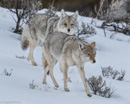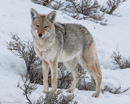Stephen Fischer Photography
Winter in Yellowstone
page 3 of 6
I seemed to have the best luck for coyote photography at either edge of the day. On the drive back of the second evening at dusk I got lucky with a sighting of one particular coyote off to the side of the road. Pulling off to the side the best I could, I started photographing it with the 500mm on a monopod. Soon other coyotes part of the same pack showed up over the ridge, all showing interest at something near where I happened to be standing. Looking down below the shoulder of the road I noticed another coyote digging into a hole in snow bank with some blood at the entrance. It looked like it may have killed another animal such as a red fox, and the other coyotes were coming in to also partake in the feeding. After photographing these various coyotes and their interactions for another few minutes, I got back in my car to leave them in peace to enjoy their meal. It was interesting to note the different personalities with these animals and wonder about the difficulties in their lives. Some showed evident scars from skrimishes of the past as seen in the images 36-42 below.
Driving back to Mammoth that evening I also happened to get behind an unusual truck with a large barrel shaped camera on a roof-mounted moveable turret (image 43). During the drive this camera would pivot in 360 degrees while the truck was driving at normal speeds, sometimes fixating at particular sights. It appeared to be some type of expensive gyro-stabilized design like you would find in a helicopter. I am not sure who they were affilated with, suspecting that it may be some type of field trail from some type of technology company given the California plate.
Finding wolves tended to cause the biggest attraction with the park visitors in the Lamar Valley. While on this visit the author noted about three different cars associated with a local wolf conservancy organization, each outfitted with 2-way radios for communication and receivers for picking up the signal from the radio collars of various pack members. These conservancy members tended to also be in communication with some of the park related wolf sightseeing bus drivers, helping coordinate sightings for these tourists. By being mindful of these vehicles (with their multiple antennas on the roof), one would often have a clue if there was wolf activity in the area without having to sign up for one of these canned tours with their fixed times. However, most of the wolf sighting that I encountered in this manner tended to be quite distance, with a pack of 3-8 typically being a mile from the road. Most of the “wolfers” tended to be content with this situation, using their Swarovski 40-80x birding scopes to view them. But from a quality photography standpoint, this distance was less than satisfying.
The two most common areas for these wolf sightings tended to be either: (a) From a couple of different pull-outs at the northwest edge looking toward Blacktail Plateau Creek. (b) From the eastern half of the Lamar Valley to where it bends up to the north at the end past Soda Butte.
<page 4 of article continued on the next page>















